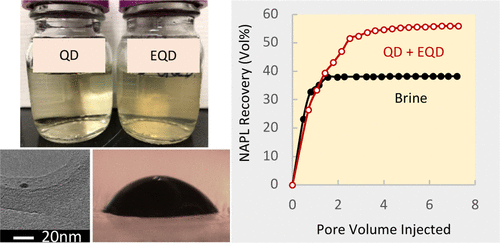当前位置:
X-MOL 学术
›
ACS Appl. Nano Mater.
›
论文详情
Our official English website, www.x-mol.net, welcomes your feedback! (Note: you will need to create a separate account there.)
Graphene Quantum Dots for the Mobilization and Solubilization of Nonaqueous Phase Liquids in Natural Porous Media
ACS Applied Nano Materials ( IF 5.9 ) Pub Date : 2020-11-05 , DOI: 10.1021/acsanm.0c01937 Kaustubh S. Rane 1 , Lamia Goual 1 , Bingjun Zhang 1
ACS Applied Nano Materials ( IF 5.9 ) Pub Date : 2020-11-05 , DOI: 10.1021/acsanm.0c01937 Kaustubh S. Rane 1 , Lamia Goual 1 , Bingjun Zhang 1
Affiliation

|
This study proposes an approach to synthesize graphene quantum dots (QDs) with remarkable physicochemical properties that allow them to effectively mobilize and solubilize nonaqueous phase liquids (NAPLs) such as crude oils in porous media. QDs are first extracted by mild oxidation of coal and then partially functionalized by alkylamines using a starch template to generate engineered QDs (EQDs). When mixed in equal amounts, the nanofluid can synergistically interact at oil/water interfaces and lower the interfacial tension (IFT) from 19.6 to 0.9 mN/m. The two quantum dots exhibit different behavior on minerals. EQDs do not adsorb because of steric hindrance caused by their aliphatic tails, whereas QDs adsorb moderately on sandstones through hydrogen bonding, leading to wettability alteration from oil-wet to weakly water-wet state. The nanofluid provides mixed-wet conditions that, together with IFT reduction, result in 21 vol % of incremental NAPL recovery compared to waterflooding. The performance of this mixture is curbed in carbonates with only 9.6 vol % of additional recovery because of strong QD adsorption and pore plugging. The ability of this nanofluid to alter wettability was further confirmed in a miniature silicate-rich rock using X-ray microtomography. The in situ contact angle distributions on quartz and carbonate shifted to a more water-wet state and covered a wide range of values, denoting a nonuniform wettability reversal. Thus, the application of QD-based nanofluids is more suitable in silicate-rich formations where chemical retention by the rock is minimum. This study paves the way for the development of more EQDs by tuning their structure via chemical functionalization of their oxygen-rich active sites.
中文翻译:

天然多孔介质中非水相液体动员和增溶的石墨烯量子点
这项研究提出了一种合成具有显着理化特性的石墨烯量子点(QD)的方法,该量子点使它们能够有效地动员并溶解非水相液体(NAPL),例如多孔介质中的原油。首先通过煤的轻度氧化来提取QD,然后使用淀粉模板通过烷基胺对QD进行部分功能化以生成工程QD(EQD)。当以等量混合时,纳米流体可以在油/水界面处协同相互作用,并将界面张力(IFT)从19.6降至0.9 mN / m。这两个量子点在矿物上表现出不同的行为。EQD由于其脂肪族尾部引起的位阻而不能吸附,而QD通过氢键在砂岩上适度吸附,从而导致润湿性从油湿状态变为弱水湿状态。纳米流体提供了混合湿润条件,与IFT降低相比,与注水相比,NAPL回收增量为21%(体积)。由于强的QD吸附和孔堵塞作用,这种混合物的性能受到碳酸盐的限制,只有9.6%(体积)的额外回收率。使用X射线显微断层摄影术在微型富含硅酸盐的岩石中进一步证实了这种纳米流体改变润湿性的能力。的 使用X射线显微断层摄影术在微型富含硅酸盐的岩石中进一步证实了这种纳米流体改变润湿性的能力。的 使用X射线显微断层摄影术在微型富含硅酸盐的岩石中进一步证实了这种纳米流体改变润湿性的能力。的石英和碳酸盐上的原位接触角分布转变为更湿润的状态,并覆盖了很宽的数值范围,表明润湿性反转不均匀。因此,基于QD的纳米流体的应用更适合岩石中化学保留量最小的富含硅酸盐的地层。这项研究通过通过富氧活性位点的化学官能化调节其结构,为开发更多的EQD铺平了道路。
更新日期:2020-11-25
中文翻译:

天然多孔介质中非水相液体动员和增溶的石墨烯量子点
这项研究提出了一种合成具有显着理化特性的石墨烯量子点(QD)的方法,该量子点使它们能够有效地动员并溶解非水相液体(NAPL),例如多孔介质中的原油。首先通过煤的轻度氧化来提取QD,然后使用淀粉模板通过烷基胺对QD进行部分功能化以生成工程QD(EQD)。当以等量混合时,纳米流体可以在油/水界面处协同相互作用,并将界面张力(IFT)从19.6降至0.9 mN / m。这两个量子点在矿物上表现出不同的行为。EQD由于其脂肪族尾部引起的位阻而不能吸附,而QD通过氢键在砂岩上适度吸附,从而导致润湿性从油湿状态变为弱水湿状态。纳米流体提供了混合湿润条件,与IFT降低相比,与注水相比,NAPL回收增量为21%(体积)。由于强的QD吸附和孔堵塞作用,这种混合物的性能受到碳酸盐的限制,只有9.6%(体积)的额外回收率。使用X射线显微断层摄影术在微型富含硅酸盐的岩石中进一步证实了这种纳米流体改变润湿性的能力。的 使用X射线显微断层摄影术在微型富含硅酸盐的岩石中进一步证实了这种纳米流体改变润湿性的能力。的 使用X射线显微断层摄影术在微型富含硅酸盐的岩石中进一步证实了这种纳米流体改变润湿性的能力。的石英和碳酸盐上的原位接触角分布转变为更湿润的状态,并覆盖了很宽的数值范围,表明润湿性反转不均匀。因此,基于QD的纳米流体的应用更适合岩石中化学保留量最小的富含硅酸盐的地层。这项研究通过通过富氧活性位点的化学官能化调节其结构,为开发更多的EQD铺平了道路。



























 京公网安备 11010802027423号
京公网安备 11010802027423号